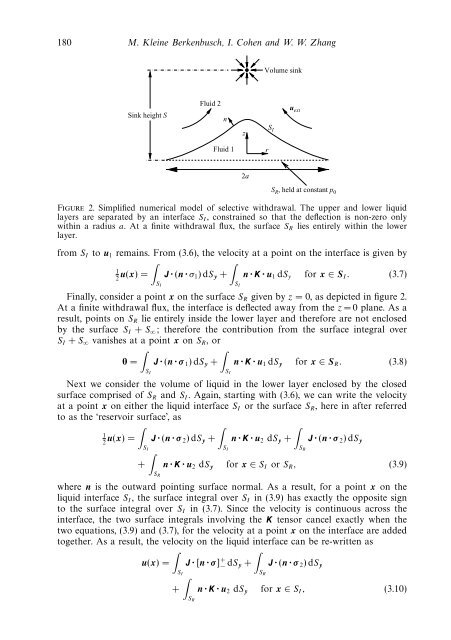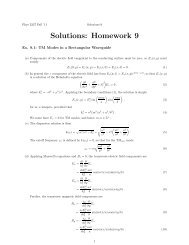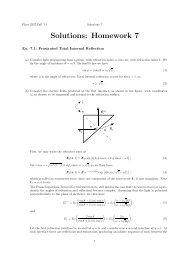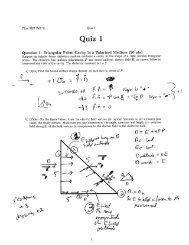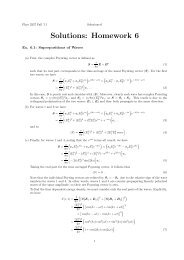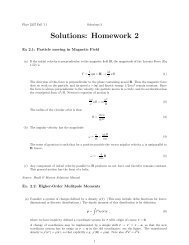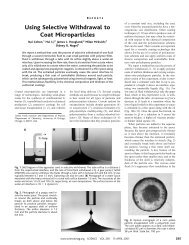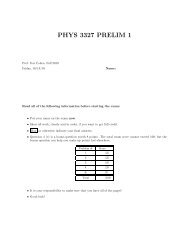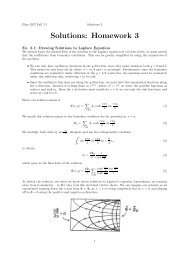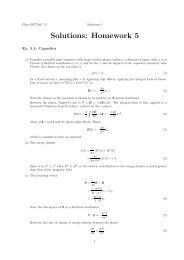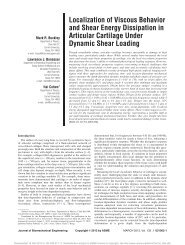<strong>Liquid</strong> <strong><strong>in</strong>terfaces</strong> <strong>in</strong> <strong>viscous</strong> stra<strong>in</strong><strong>in</strong>g <strong>flows</strong> 179Therefore, u 2 , the disturbance velocity field <strong>in</strong> the lower layer, satisfies∇·σ 2 = −∇p 2 + μ∇ 2 u 2 = 0, ∇·u 2 = 0, (3.4)where p 2 is the pressure field <strong>in</strong> the lower layer and σ 2 thefluidstressfield<strong>in</strong>thelower layer.S<strong>in</strong>ce the flow dynamics <strong>in</strong> both layers are described by the l<strong>in</strong>ear Stokes equations,we can represent the velocity field as an <strong>in</strong>tegral over a suitably def<strong>in</strong>ed closedsurface, as discussed <strong>in</strong> earlier works and <strong>in</strong> textbooks on <strong>viscous</strong> flow (Lorentz1907; Ladyzhenskaya 1963; Pozrikidis 1992). The key result of the boundary-<strong>in</strong>tegralformulation is that a Stokes velocity field u at a po<strong>in</strong>t x is given by an <strong>in</strong>tegral overany closed surface S enclos<strong>in</strong>g x. The surface <strong>in</strong>tegral has the form∫∫u(x) = J(r) · [n · σ ( y)] dS y + n · K(r) · u( y) dS y , (3.5)Swhere y is the po<strong>in</strong>t on the surface that is be<strong>in</strong>g <strong>in</strong>tegrated over and n is an outwardpo<strong>in</strong>t<strong>in</strong>gsurface normal. The tensors J and K are def<strong>in</strong>ed as:J(r) = 1 ( 18πμ r + rr ), K(r) =− 3 rrr(r = x − y).r 3 4π r 5Physically, (3.5) <strong>in</strong>dicates that the velocity at the <strong>in</strong>terior po<strong>in</strong>t x can be expressed asa sum over two different k<strong>in</strong>ds of contributions over the closed surface S. The firstterm on the right-hand side of (3.5) corresponds to the fluid stress exerted by <strong>flows</strong>past the enclos<strong>in</strong>g surface. The second term describes contributions correspond<strong>in</strong>g to<strong>flows</strong> <strong>in</strong>to and along the closed surface S. If the po<strong>in</strong>t x lies outside the enclosedvolume, the contributions over the closed surface cancel, so that the right-hand sideof (3.5) sums to 0. A po<strong>in</strong>t on the closed surface S is a special case. When the closedsurface S is cont<strong>in</strong>uous and smoothly vary<strong>in</strong>g, the velocity at x is simply an averageof the contribution from S to x if it is <strong>in</strong> the exterior and the contribution from S tox if it is an <strong>in</strong>terior po<strong>in</strong>t. As a result, the velocity for a po<strong>in</strong>t x on the surface S canbe written as∫1u(x) = 2SS∫J(r) · [n · σ ( y)] dS y + n · K(r) · u( y) dS y . (3.6)SThese results allow us to derive an <strong>in</strong>tegral equation for the time-evolution of the<strong>in</strong>terface <strong>in</strong> our idealized withdrawal problem. We def<strong>in</strong>e the surface S ∞ , which hasthe shape of a hemispherical shell with radius R ∞ such that R ∞ goes to <strong>in</strong>f<strong>in</strong>ity.We then divide the liquid <strong>in</strong>terface <strong>in</strong>to two portions, an <strong>in</strong>ner portion, denoted byS I , correspond<strong>in</strong>g to the <strong>in</strong>terface with<strong>in</strong> a radial distance a of the orig<strong>in</strong>, and anouter portion, denoted by S O , correspond<strong>in</strong>g to the rest of the <strong>in</strong>terface. We thenassume that the s<strong>in</strong>k height is always much smaller than a so that contributionsfrom the <strong>in</strong>tegral over S O are small compared with contribution from S I , and entirelydiscard the contribution from S O . Our numerical results show that this is a reasonableprocedure as long as the s<strong>in</strong>k height ˜S is smaller than a (§ 4.2). In that regime, thehump height and radius of curvature are little <strong>in</strong>fluenced by the errors <strong>in</strong>curred<strong>in</strong> neglect<strong>in</strong>g S O . Start<strong>in</strong>g from (3.5) and neglect<strong>in</strong>g the contribution from S O ,thedisturbance velocity u 1 <strong>in</strong> the upper layer can be written as a sum of <strong>in</strong>tegrals over S Iand S ∞ .S<strong>in</strong>ceu 1 decays rapidly to 0 at <strong>in</strong>f<strong>in</strong>ity, the contributions from the <strong>in</strong>tegralsover the shell S ∞ approach 0 as R ∞ is taken to <strong>in</strong>f<strong>in</strong>ity, so that only the contribution
180 M. Kle<strong>in</strong>e Berkenbusch, I. <strong>Cohen</strong> and W. W. ZhangVolume s<strong>in</strong>kS<strong>in</strong>k height SFluid 2nFluid 1zrS Iu ext2aS R , held at constant p 0Figure 2. Simplified numerical model of selective withdrawal. The upper and lower liquidlayers are separated by an <strong>in</strong>terface S I , constra<strong>in</strong>ed so that the deflection is non-zero onlywith<strong>in</strong> a radius a. At a f<strong>in</strong>ite withdrawal flux, the surface S R lies entirely with<strong>in</strong> the lowerlayer.from S I to u 1 rema<strong>in</strong>s. From (3.6), the velocity at a po<strong>in</strong>t on the <strong>in</strong>terface is given by∫1u(x) = J · (n · σ2 1 )dS y + n · K · u 1 dS y for x ∈ S I . (3.7)∫S I S IF<strong>in</strong>ally, consider a po<strong>in</strong>t x on the surface S R given by z = 0, as depicted <strong>in</strong> figure 2.At a f<strong>in</strong>ite withdrawal flux, the <strong>in</strong>terface is deflected away from the z = 0 plane. As aresult, po<strong>in</strong>ts on S R lie entirely <strong>in</strong>side the lower layer and therefore are not enclosedby the surface S I + S ∞ ; therefore the contribution from the surface <strong>in</strong>tegral overS I + S ∞ vanishes at a po<strong>in</strong>t x on S R ,or∫∫0 = J · (n · σ 1 )dS y + n · K · u 1 dS y for x ∈ S R . (3.8)S I S INext we consider the volume of liquid <strong>in</strong> the lower layer enclosed by the closedsurface comprised of S R and S I . Aga<strong>in</strong>, start<strong>in</strong>g with (3.6), we can write the velocityat a po<strong>in</strong>t x on either the liquid <strong>in</strong>terface S I or the surface S R , here <strong>in</strong> after referredto as the ‘reservoir surface’, as∫∫1u(x) = J · (n · σ2 2 )dS y + n · K · u 2 dS y + J · (n · σ 2 )dS y∫S I S I S∫R+ n · K · u 2 dS y for x ∈ S I or S R , (3.9)S Rwhere n is the outward po<strong>in</strong>t<strong>in</strong>g surface normal. As a result, for a po<strong>in</strong>t x on theliquid <strong>in</strong>terface S I , the surface <strong>in</strong>tegral over S I <strong>in</strong> (3.9) has exactly the opposite signto the surface <strong>in</strong>tegral over S I <strong>in</strong> (3.7). S<strong>in</strong>ce the velocity is cont<strong>in</strong>uous across the<strong>in</strong>terface, the two surface <strong>in</strong>tegrals <strong>in</strong>volv<strong>in</strong>g the K tensor cancel exactly when thetwo equations, (3.9) and (3.7), for the velocity at a po<strong>in</strong>t x on the <strong>in</strong>terface are addedtogether. As a result, the velocity on the liquid <strong>in</strong>terface can be re-written as∫∫u(x) = J · [n · σ ] + − dS y + J · (n · σ 2 )dS yS I S∫R+ n · K · u 2 dS y for x ∈ S I , (3.10)S R


